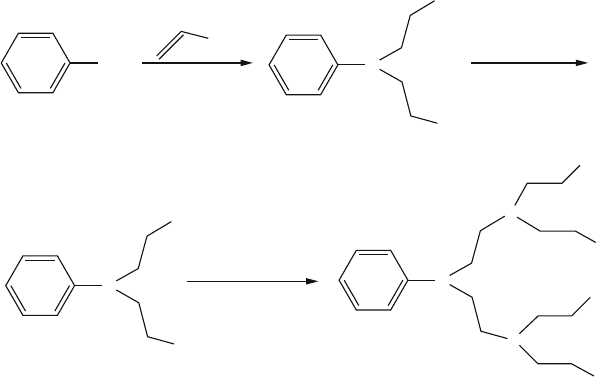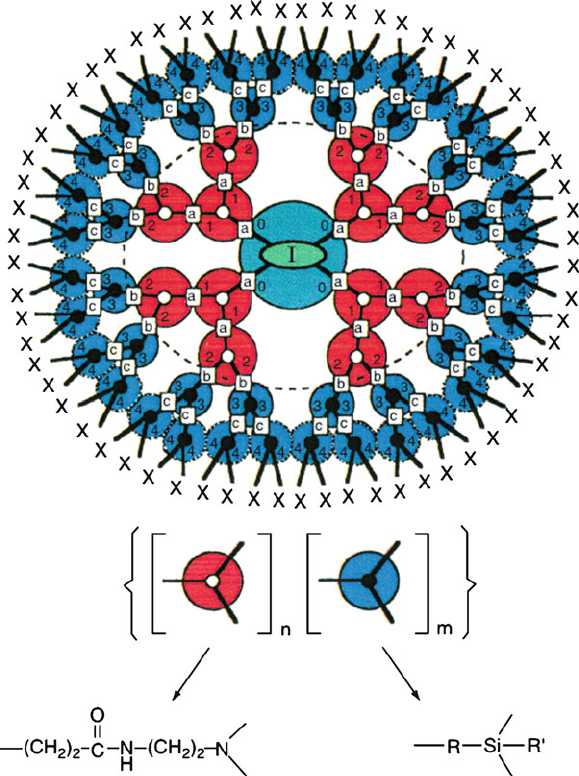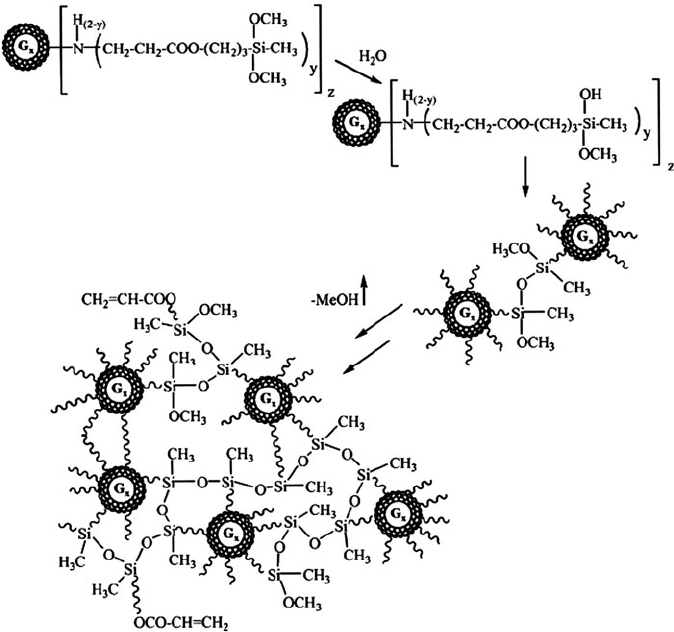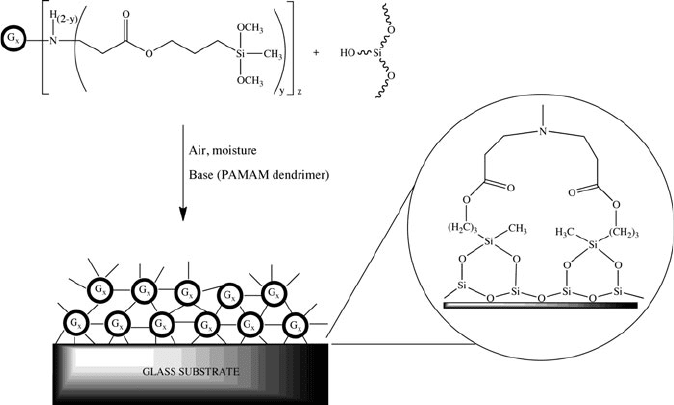Fahlman B.D. Materials Chemistry
Подождите немного. Документ загружается.


incomplete/side reactions, which are not easily removed from the solution due to
their structural similarity to the final product.
In order to circumvent the purity issues associated with divergen t syntheses,
Frechet and coworkers designed a convergent approach in the late 1980s.
[33]
In contrast to the divergent approach, growth initiates from the exterior of the
molecule progressing inwardly by coupling endgroups to each branch of the mono-
mer (Figure 5.30b). The functional group at the focal point of the wedge-shaped
dendritic fragment (known as a dendron) may be reacted with additional monomers
to build up higher-generation dendr ons. When the desired generation dendron is
reached, these units are then attached to a polyfunctional core to form the final
dendrimer. This route drastically increases the purity of higher-generation dendri-
mers relative to divergent syntheses, as there are much fewer reactions per molecule.
In addition, the reactions only require a slight excess of reagent, in contrast to the
large exces ses that were essential for divergent growth. However, this technique is
not useful for commercial large-scale dendrimer synthesis, as the mass of the sample
decreases with additional generation growth, and low yields of higher-generation
dendrimers due to steric crowding around the focal point of the growing dendron.
Nevertheless,this is the only route that offers precise structural control over the growing
dendrimer, such as being able to modify the focal point/chain ends to yield well-defined
unsymmetrical dendrimers. This strategy is being developed to synthesize “bowtie”
dendrimers containing both target and drug-delivery agents (Figure 5.31). As an alter-
native strategy for drug delivery, surface modification of PAMAM with cancer targets
CN
N
CN
CN
CH
3
COOH
(Michael addition rxn)
i) Michael add'n
of more acrylonitrile
ii) reduction
Co
3-
, NaBH
4
MeOH
(reduction)
NH
2
NH
2
N
N
N
N
NH
2
NH
2
NH
2
NH
2
...
NH
2
Figure 5.27. The V
€
ogtle approach to yield low molecular weight amines via controlled sequential
synthesis.
378 5 Polymeric Materials

and anticancer drugs (Figure 5.32) has also been proven successful in preliminary trials.
We will further discuss advances in drug-delivery agents later in this chapter.
To date, the PAMAM dendrimer remains the most heavily utilized for applica-
tions, due to its facile scale-up and commercial availability. In Chapter 6, we will
discuss its use as a nanoreactor/nanocapsule stabilizing agent for nanoparticle
growth within both aqueous or organic solvent media.
[34]
Not only can one alter
its solubility characteristics by changing the peripheral moieties from hydrophilic/
hydrophobic character, but also its overall properties. For instance, Starpharma in
association with Dendritic Nanotechnologies, Inc. have developed a HIV/AIDS
drug that is based on a PAMAM architecture functionalized with sulfonic acid end
groups.
[35]
However, if the terminal groups are changed to oligo(ethylene glycol), the
dendrimer may be used as a pore generating agent in the development of dielectric
thin films for microelectronic devices.
[36]
Poly(lysine) dendrimers modified with
sulfonated napthyl groups have shown activity as antiviral drugs against the herpes
simplex virus.
[37]
Svenson and Tomalia provide a nice review of the multifaceted
Figure 5.28. Illustration of resultant polymers through varying the degree of control of step-growth
polymerization. Each successive growth layer is referred to as a generation (G). Reproduced with
permission from Frechet, J. M. J.; Tomalia, D. A. Dendrimers and Dendritic Polymers, Wiley:
New York, 2001.
5.2. Polymerization Mechanisms 379

Figure 5.29. The Newkome approach for the sequential step-growth of arborols.
Table 5.3. Comparative Properties of Dendrimers and Linear Polymers
a
Property Dendrimers Linear polymers
Structure Compact, globular Not compact
Synthesis Controlled, stepwise growth Single-step polycondensation
Structural control Very high Low
Architecture Regular Irregular
Shape Spherical Random coil
Crystallinity Non-crystalline, amorphous Semi-crystalline/crystalline
T
g
Lower Higher
Aqueous solubility High Low
Nonpolar solubility High Low
Viscosity Non-linear relationship w/ M
w
Linear relationship w/ M
w
Compressibility Low High
Polydispersity Monodisperse Polydisperse
a
http://www.pharmainfo.net/reviews/dendrimer-overview
380 5 Polymeric Materials

Figure 5.30. Schematic comparison of (a) divergent and (b) convergent dendrimer synthetic routes.
Reproduced with permission from Grayson, S. M.; Frechet, J. M. J. Chem. Rev., 2001, 101, 3819.
Copyright 2001 American Chemical Society.
5.2. Polymerization Mechanisms 381

use of dendrimers for biomedical applications;
[38]
Li and Aida provide a review of
dendrimer porphyrins and phthalocyanines, which have attracted recent interest as
sensitizers for photodynamic theraphy (PDT) and biosensing applications.
[39]
The first “co-polymer dendrimer” was developed by Dvornic and coworkers,
which feature both a hydrophilic PAMAM core and a hydrophobic organosilicon
shell (Figure 5.33).
[40]
This structure proves extremely useful for the encapsulation
of polar species within organic solvents, for the growth of nanoparticles (Chapter 6).
Due to the water-sensitive alkoxysilyl groups (e.g., Si—OCH
3
), facile network
formation may also take place (Figure 5.34) via the analogous hydrolysis reactions
that were previously discussed for sol–gel growth of SiO
2
networks (Chapter 2). The
crosslinking of dendritic units to form an extended network is sometimes referred
to as a megamer – of increasing interest for functional coat ings (e.g., sensors, smart
fabrics, etc.) applications. A further utility of the PAMAMOS structure is its
reactivity toward a glass surface, which contains silanol (Si—OH) reactive groups
(Figure 5.35). This results in a permanent coating, with a controllable degree of
surface adsorption based on the peripheral groups of the dendrimer. These properties
Figure 5.31. Bowtie dendrimer synthesized via the convergent approach, for drug delivery of anticancer
drugs to target organs. Reproduced with permission from Gillies, E. R.; Dy, E.; Frechet, J. M. J.; Szoka, F. C.
Mol. Pharm., 2005, 2, 129. Copyright 2005 American Chemical Society.
382 5 Polymeric Materials

Figure 5.32. PAMAM dendrimer multifunctional conjugates for cancer treatment. The FA group is a
folic acid cancer cell target, and FITC is fluorescein isothiocyanate, used as an imaging agent. Also
shown (bottom) is the molecular structure for the anticancer drug, taxol, denoting the —OH group
that covalently attaches to the dendrimer. Reproduced with permission from Majoros, I. J.; Myc, A.;
Thomas, T.; Mehta, C.; Baker, J. R. Biomacromolecules, 2006, 7, 572. Copyright 2006 American
Chemical Society.
5.2. Polymerization Mechanisms 383

have recently been exploited by the deposition of copper-encapsulated PAMAMOS
anti-fouling coatings on ship hulls, to prevent the adhesion of zebra mussels.
[41]
Although we have described the growth of dendritic polymers as being highly
controllable, the resultant size of the polymer is mathematically limited. This is in
direct contrast to linear polymers that may increase in size to infinity (as long as they
Figure 5.33. Illustration of a poly(amidoamine-organosilicon) (PAMAMOS) dendrimer, with two generations
of each PAMAM and organosilicon units. Although the PAMAMOS represents a block copolymer, an unlimited
number of other variations that contain a random copolymer array, or varying dendron subunits, may also be
synthesized. Reproduced with permission from Dvornic, P. R.; Owen, M. J. Synthesis and Properties of Silicones
and Silicone-Modified Materials, ACS Symposium Series 838, 2002, 236.
384 5 Polymeric Materials

remain soluble within the solvent). As the dendritic structure grows, there become
significant steric interactions amo ng the exponentially increasing number of periph-
eral groups. This phenomenon is known as the De Gennes dense packing,
[42]
and
results in a more structurally flawed, globular structure as the dendrimer generation
increases.
Figure 5.34. Network (megamer) formation through the hydrolysis/crosslinking of neighboring
PAMAMOS dendrimer units. Hydrolysis of the C—O—Si bond may also be exploited for the
controlled-release of entrained agents (e.g., cancer drugs, etc.). It should be noted that subsequent
thermal annealing to remove the PAMAM cores results in a nanoporous network that has a dielectric
constant (k)ofca. 1.5 – of extreme interest for next-generation low-k IC interconnect applications.
Reproduced with permission from Dvornic, P. R.; Li, J.; de Leuze-Jallouli, A. M.; Reeves, S. D.; Owen,
M. J. Macromolecules, 2002, 35, 9323. Copyright 2002 American Chemical Society.
5.2. Polymerization Mechanisms 385

5.2.6. Polymerization via “Click” Chemistry
As we know from experiment, any chemical reaction will result in byproducts and
side-reactions that will limit the overall yield to <100%. Quantitative yields are
quite rare for synthetic chemistry; that is, until the introduction of click chemistry by
Sharpless and coworkers in 2001.
[43]
By definition, click chemistry involves reac-
tions that occur by high/quantitative yield, generate few/no byproducts, and are
stereospecific – setting an important precedent toward mimicking nature’s synthetic
efficiency. In particular, nature efficiently links small molecules together via het-
eroatomic C—X—C bonding to yield primary metabolites (polypeptides, polynu-
cleotides, and polysaccharides – Figure 5.36), which are essential for life.
Click processes occur through simple reaction conditions such as air/moisture
insensitivity, solventless or aqueous media, readily available precursors and
reagents, and simple product isolation – mostly precluding chromatographi c
separation (unlike most organic syntheses). The utilization of click chemistry in
combination with combinatorial screening will speed up the discovery of new
pharmaceuticals that our society will continue to rely upon.
[44]
Beyond small-molecule drug discovery, click chemistry may also be exploited for
the synthesis of polymers and supramolecular architectures.
[45]
Since the overall
properties of the polymer are closely related to its side groups, this technique has
Figure 5.35. The formation of covalently bound coatings of PAMAMOS onto a glass surface.
Reproduced with permission from Dvornic, P. R.; Li, J.; de Leuze-Jallouli, A. M.; Reeves, S. D.;
Owen, M. J. Macromolecules, 2002, 35, 9323. Copyright 2002 American Chemical Society.
386 5 Polymeric Materials

been used to easily fine-tune polymeric structures by simple high-yield reactions of
monomeric units (Figure 5.37). One example is the coupling of two linear-chain
polymers to generate a block co-polymer; of significant challenge due to the reduced
reactivity of the polymeric chain ends. A strategy to accomplish this difficult
chemistry is to functionalize the endgroups with alkynyl or azido groups, which
undergo high-yielding Cu(I)-catalyzed dipolar cycloaddition reactions.
[46]
Even
dendritic polymers may be synthesized or surface-functionalized using click chem-
istry (Figure 5.38). This may be of extreme interest to the industrial and scientific
community, as the current cost of PAMAM dendrimers are still rather high. The
latest version of PRIOSTAR
TM
dendrimers developed by Tomalia and coworkers
are generated via click chemistry, and are touted to offer the analogous functionality
and applications as PAMAM dendrimers at a fraction of the cost.
[47]
Figure 5.36. Examples of molecular structures for (a) polypeptides, (b) polysaccharides, and
(c) polynucleotides.
5.2. Polymerization Mechanisms 387
